If they ever start handing out PhD’s in wild berry picking, I’ll be getting one. I’ve spent hours foraging for raspberries and blackberries, first in Maryland farming country, then later in six foreign countries and five additional American states. But right off let me give credit for my early childhood picking education to a woman named Margie, whose family’s farm adjoined ours on one side.
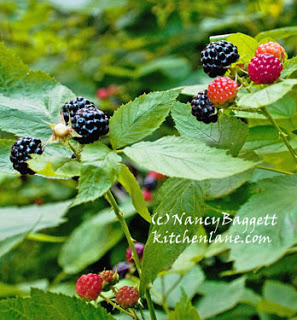 Actually, she was “Miss Margie” to me, because where I lived no child ever addressed a grownup by his or her first name. Unless the woman was a relative and could be referred to as “Cousin,” she was called “Miss,” even if she was married. And Margie was an intimidating presence, so I certainly would never have over-stepped any boundaries with her!
Actually, she was “Miss Margie” to me, because where I lived no child ever addressed a grownup by his or her first name. Unless the woman was a relative and could be referred to as “Cousin,” she was called “Miss,” even if she was married. And Margie was an intimidating presence, so I certainly would never have over-stepped any boundaries with her!
Though smallish, she was agile and appeared strong and sinewy in the way of many seasoned farm hands. She was lean almost to the point of gauntness. She look like one who had been too busy growing and preparing food to spend much time sitting and eating it, which was likely the case. Her face was leathery and parched from the sun, not surprising since both she and her husband could be seen out work with thei red Farmall tractor.
This activity, in particular, set her completely apart from the other women in our community, who, even if they planted huge gardens and harvested and canned hundreds of quarts of produce for the winter larder, never drove a tractor or handled any farm machinery. Many folks looked askance at this breach of convention, but others forgave her because she and her husband were “newcomers” from somewhere too backwards to know what work was appropriate for women. In fact, her family had been on their land since before I was born, but where I lived folks were labeled newcomers until every person who remembered their coming had passed on!
Due to their distinctive, twangy drawl and odd language—their speech was peppered with lines like, “I’m a fixin’ to plant me some corn ‘ore yonder,”—Margie and her husband always stood out and were branded as “Tennesseans.” Even if I didn’t know the actual word pejorative, I understood that this tag usually meant hillbilly, hick, or somebody from the hardscrabble Appalachian mountain states west of us. (Or maybe just a place more backwater than where we lived!)
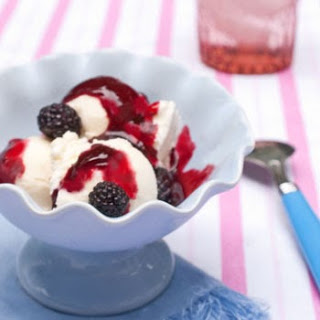
Other than nodding to her when she and my parents exchanged pleasantries in the store or post office, the only face-to-face interaction I ever recall having with Miss Margie came one day as I was picking wild black raspberries along the fence that marked the boundary between her farm and ours. I wanted to flee as I saw her nearing with her bucket, but knew she might tell my mother of my rudeness if I did.
“Nice day.” I said. “The berries don’t look too good this year—kind of seedy.” I was trying hard to engage in typical neighbor chitchat.
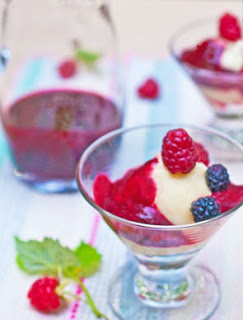
“Been worse,” she countered flatly. “Mother Nature be havin’ good years n’ bad. We best be grateful for what we git. And seedy don’t matter none when ye’re a makin’ jelly.” Feeling rebuked, I eased away, pretending to concentrate on my harvesting, and said nothing further. Thanks goodness I hadn’t reached through the fence and snitched any berries on her side, as she would surely have pointed out that clear violation of local picking protocol. She was right about the jelly, but I was longing for one of my mother’s cobblers!
I think she realized she’d sounded too harsh, because after silently picking a few minutes, she spoke in a much kinder tone. “Squat down low and look right in them canes to git what ye missed,” she offered. “Real nice, ripe ‘uns be thar ahidin’ from the birds.” Her words nice and ripe came out sounding like “nahs” and “rahp.”
When I bent down, I could see that this was true. Not only were there a surprising number of pristine, purple-black clusters glinting back at me, but shaded from the drying wind and sun, they were plumper and less seedy than those in plain sight.
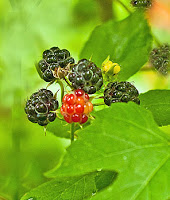
Over the next half hour she gently furnished more tips, all of which I rely on to this day. Frankly, I’m a little reluctant to share them, because I don’t want the competition if you happen to forage near my house! As Miss Margie observed, armed with her techniques you can “do right well,” even if another picker has harvested in the same spot shortly before you came!
Besides peering into the brambles at eye level, she recommended always checking the canes growing low and lifting up ones bent over to the ground (often they are bowed by the weight of their fruit!). She also suggested pulling apart branches as if they were curtains, a step that inevitably revealed a little cache (like the berries above right) tucked behind the leafy screen. (For more wild berry pics, go here.)
Another simple yet stunningly effective technique she taught me was to make a second pass through the patch, going in the opposite direction from the original foray. Just as examining a situation from a different angle inevitably seems to reveal new options, this step almost always exposes fruit that was missed the first time around.
In case you are a newbie forager, let me pass along some more rudimentary suggestions of my own. Be sure to wear full length pants and a heavy, long-sleeved shirt so that when the briars reach out and snag you, they’ll rip clothing and not your flesh. And take a larger container than you think you’ll need. While it’s a little painful to come home with a paltry haul in a huge bucket, it’s pure torture to have to leave succulent berries in the patch just because your container is full!
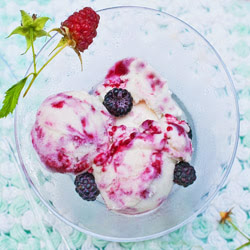 Raspberry Sauce for Sundaes and Ripple Ice Cream
Raspberry Sauce for Sundaes and Ripple Ice Cream
If you can find black raspberries (yes, raspberries that are purple-black like blackberries) either in fields or farmers’ markets, do try them in this recipe. They are particularly delicious when paired with the more familiar red variety, as they have a deep fruitiness and tang that IMHO gives the red even more appeal than they have served solo. Using half of each yields a vibrant purple-red color, as you can see in the sundae pics here. (You can easily tell black raspberries from blackberries; the raspberries will be hollow underneath from growing cap-like over the protruding nubs of blooms. Which explains why they are sometimes called “blackcaps.”)
It’s, of course, easiest to simply spoon the sauce over ice cream—and the results will be sublime. But the recipe is designed so it can be swirled in and frozen to create a glorious homemade raspberry ripple ice cream. The ripple ice cream shown was created simply by swirling sauce into slightly softened store-bought vanilla ice cream, then freezing it until firm again. (The homemade raspberry ice cream recipe that incorporates the sauce is here.) Both the small amount of cornstarch and corn syrup called for help prevent the texture of the sauce from becoming hard or gritty in the freezer, so do not even think about leaving these ingredients out!
Tip: This same recipe can be used to make a blackberry sauce.
3 1/2 to 4 cups red or black (or a combo) raspberries, washed and patted dry
1/2 cup granulated sugar (or a little more for really tart berries)
Generous 1/2 cup, plus 2 tablespoons water, divided
1 tablespoon light corn syrup
1 teaspoon lemon zest and 1 teaspoon fresh lemon juice, optional
2 teaspoons cornstarch
Stir together the berries, sugar, 1/2 cup water, the corn syrup, lemon zest and juice (if using) in a medium nonreactive saucepan. Bring to a boil, stirring, over medium heat. Adjust the heat so the mixture boils gently, then cook for 10 to 12 minutes or until the berries are soft and have broken down. In a cup, stir together the cornstarch with 2 tablespoons cool water until well blended. Stir the mixture into the berries and bring to a gentle boil; boil for 2 minutes.
Remove from the heat and let cool to warm. Stir the mixture through a fine sieve (one fine enough to catch the seeds) into a nonreactive storage container. Keep stirring and pressing down until as much juice and pulp is forced through as possible. Scrape off any pulp on the underside of the sieve into the non-reactive storage container. Stir the mixture and if necessary thin it with more water until a saucy consistency is reached. Use immediately, if desired, at room temperature as a sundae sauce; or refrigerate, covered, for up to 4 or 5 days.
Use the thoroughly chilled sauce to swirl through ice cream for a raspberry ripple ice cream. The sauce thickens in the refrigerator, so you may want to thin it by stirring in a little water if using it as a sundae sauce. If using it to ripple through ice cream, don’t thin it; the slightly thickened consistency is what you need.
Makes about 1 cup of sauce, enough for 7 or 8 sundaes, or 1 batch of raspberry ripple ice cream.
Here’s my raspberry crumb cobbler recipe, which you might also like.
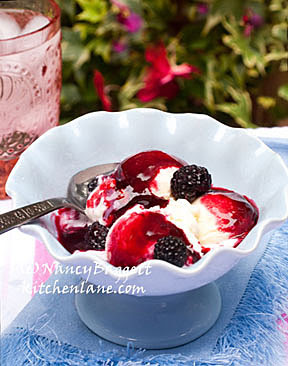


Thanks Sally, I wondered if you'd remember her. I started thinking about her as I was picking raspberries in June.
I remember Miss Margie well but your discriptions have brought back even more memories. I can actually see her after more than 45 years away from the area.
I was so suprised on July 4th when all the men stood around with spoons waiting for the raspberry dessert to be ready….some had not waited as there were several holes around the edges of the dish.Thank you….Sally
Jackie, thanks for your comments on the pics–been concentrating on improving them. I didn't mention the slithery things. The picking guru said one should stomp loudly when approaching a patch to scare they away.
Jamie, I'm thrilled that you like this story. You are a very fine writer, so this is high praise indeed.
What a wonderful story, Nancy! I love it, vivid, evocative, touching and amusing. And the berry ice cream! Wow is it gorgeous! I love the sauce and since I don't have the freezer to make ice cream I will try your sauce!
I'm right there with you in earning an advanced degree in berry picking! I've spent many hours waist deep in thorns and berry canes just hoping a slithery friend wasn't nearby. Stunning photos!
Doctoring bought ice cream–a great idea. Thanks